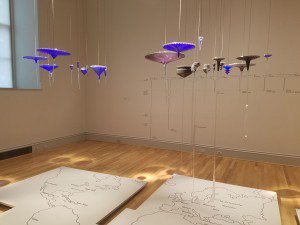In case you haven’t noticed (because you’ve either awoken from a 15-year coma, raised by feral wolves, or a little of both), 2016 is an election year. Don’t worry — I will refrain from any political discourse.
The election did inspire me and two friends to take a day trip to Washington, D.C. to see the sights. We tried to venture to different types of attractions and eventually ended up at the Renwick Galley at the Smithsonian American Art Museum. One of my friends, Amanda, is an art teacher. She also possesses a crazy knowledge of all things art, so I love going to galleries with her.
The Renwick focuses on contemporary craft art — sculptures, pottery and installation pieces. While exploring, I stumbled across Norwood Viviano’s “Global Cities.” On the floor lay separate white panels with black outlines of the continents with the names of major cities geographically highlighted. The panels were arranged to provide an almost seamless view of the map. Above the panels were 29 pieces of blown glass, each a different size and shape. The glass hovered above a specific city.
The size and shape of the glass corresponded with amount of time humans had inhabited the area and how the population had grown or declined. It was a breathtaking sight. An exhibit specialist at the Renwick explained that population data was used to create the blown glass. The piece was meant to showcase the true distribution of populations through the use of a grand visual display.
This piece showed what all data nerds like me feel: Data can be beautiful.
While I stood transfixed, Amanda explained that artists were beginning to utilize data more in their pieces. I honestly never saw the connection before her statement. Art is, well, art. It can be anything. There are no rules. Data is the exact opposite. It’s regimented and structured. Their marriage, though, has the ability to create understanding for a whole slew of people. Ergo, art is able to unlock the true job of data, which is bringing information to light.
This brings up an intriguing insight. Perhaps things we had a preconceived notion about in marketing bear a second look. Maybe an audience who was perceived as not being receptive to a message should get a deeper dive. A failed campaign re-examined to understand what went

“Global Cities”
If you ever get a chance to check out the Renwick and this piece, I highly recommend it. You may find it as inspiring as I did. I also recommend taking as many ridiculous pictures as you can in front of the Washington Monument. Why? No real reason, except to possibly annoy everyone around you.
By Marisa Albanese, database marketing analyst at Annodyne

